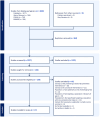Intervention strategies for type 2 diabetes prevention in high-income countries targeting low socioeconomic groups: a scoping review
- PMID: 40786170
- PMCID: PMC12331585
- DOI: 10.3389/fpubh.2025.1583817
Intervention strategies for type 2 diabetes prevention in high-income countries targeting low socioeconomic groups: a scoping review
Abstract
Introduction: Type 2 diabetes is increasing worldwide, and the trend is also observed in Sweden. In Malmö, the third largest city in Sweden, the prevalence has doubled. Populations with lower socioeconomic status have a higher prevalence and poorer outcomes, making preventive interventions targeting these groups increasingly important.
Objective: To investigate the types of interventions that have been tested and reported regarding the prevention of type 2 diabetes targeting low socioeconomic populations and are applicable in a high-income country.
Methods: Based on a systematic search strategy developed using the People, Concept, and Context model, the databases CINAHL, PubMed, and Web of Science were searched in January 2024 and updated in December 2024, and EMBASE was searched in May 2025. A flowchart of the screening process has been created. From the selected studies, data were extracted, charted, and the findings were compiled in a narrative form.
Results: Seventeen studies were included, 12 were conducted in the United States and five in Europe. Most used culturally adapted diabetes prevention programs, and a higher proportion of participants were women. Key features included flexibility in attendance and format, development through a community-based participatory approach, gender-specific groups, and the involvement of significant others. Increases of physical activity proved challenging within broader lifestyle interventions. Screening interventions were conducted in community and healthcare facility settings, as well as through a school-and community-based program. Challenges with enrollment and retention were commonly reported.
Conclusion: There is a need for more interventions in the European context and for interventions to engage more men with strategies such as male peer coaches and community screening in locations frequented by men. Longer time frames and sustained engagement strategies are necessary to reach and retain groups with low socioeconomic status in preventive type 2 diabetes interventions.
Keywords: intervention studies; low socioeconomic status; prediabetes; prevention; type 2 diabetes.
Copyright © 2025 Thylefors, Annersten Gershater, Mangrio and Zdravkovic.
Conflict of interest statement
The authors declare that the research was conducted in the absence of any commercial or financial relationships that could be construed as a potential conflict of interest.
Figures
References
-
- Sun H, Saeedi P, Karuranga S, Pinkepank M, Ogurtsova K, Duncan BB, et al. IDF diabetes atlas: global, regional and country-level diabetes prevalence estimates for 2021 and projections for 2045. Diabetes Res Clin Pract. (2022) 183:109119. doi: 10.1016/j.diabres.2021.109119, PMID: - DOI - PMC - PubMed
Publication types
MeSH terms
LinkOut - more resources
Full Text Sources
Medical


